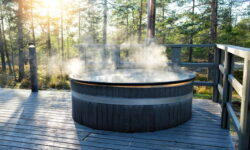You’re probably wondering, “What age can you safely soak in a hot tub?” Whether you’re a parent, a teenager, an adult, or a senior, it’s essential to know how hot tub use impacts different age groups.
Children under the age of 5 should not use a hot tub due to the risk of overheating or dehydration. For those aged 5 and above, it is generally considered safe but they should be closely supervised, limit their time, and avoid full body submersion, especially if the water is very hot.
From safety guidelines to health considerations, we’ll cover everything you need to know. Dive into this guide and discover how to enjoy your hot tub experience safely, no matter your age.
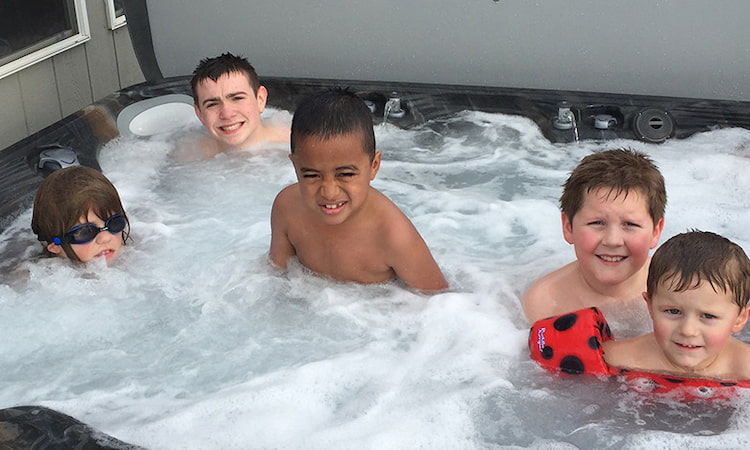
Quick Navigation
Understanding the Risks of Hot Tub Use for Different Age Groups
Before you hop into a hot tub, it’s crucial you understand the risks associated with its use for different age groups. For infants and toddlers, hot tubs can pose a significant danger. Their small bodies can’t regulate temperature as effectively as adults, making them more susceptible to overheating. Plus, there’s the risk of waterborne illnesses and the potential for accidents.
Now, let’s talk about adolescents and young adults. While they’re better equipped to handle the heat, they must be mindful of the time they spend soaking. Overexposure can lead to dehydration and heat exhaustion.
For the elderly, the concerns are twofold. Firstly, hot water can exacerbate certain health conditions, such as heart disease. Secondly, the risk of slips and falls increases.
But don’t worry. Regular cleaning and disinfection will keep waterborne illnesses at bay. Setting a safe water temperature (ideally around 100°F) and limiting soak time can prevent overheating. Installing non-slip surfaces can reduce fall risks.
Related Read: Is a Hot Tub Good for Neuropathy? Why & Why Not?
Safety Guidelines for Children in Hot Tubs
You’ve got to ensure your child’s safety when using hot tubs, as there are specific guidelines to follow. Hot tubs can pose risks to children owing to their high temperatures and the potential for accidental drowning. Consequently, you need to adhere to specific safety measures to protect them.
Firstly, always supervise your children when they’re in or around the hot tub. This can prevent accidents and ensure immediate action if something goes wrong. Secondly, educate your kids about safety rules such as not running around the hot tub, avoiding submersion, and limiting their time inside the tub.
To further help you, here are some additional safety considerations:
- Keep the hot tub’s temperature under 104 degrees Fahrenheit. For kids, it’s better to keep it even lower, around 95 degrees.
- Make sure the hot tub’s cover is secure when not in use to prevent unsupervised access.
- Regularly check and maintain the hot tub’s water quality to prevent skin irritation and eye issues.
Impact of Hot Tubs on Adolescents
As your child transitions into adolescence, the impact of hot tub use changes, and it’s crucial to understand these differences. Adolescents have more physical resilience than young children, which makes them less susceptible to temperature-related issues. However, this doesn’t mean they should spend unlimited time hot-tubbing. Even adolescents should limit their soak to 15-20 minutes and avoid submerging their heads.
The heat from the tub can cause dizziness, especially when getting out, so it’s important they rise slowly. Additionally, hot tubs may exacerbate skin conditions common in adolescence, like acne. Ensure the tub is clean and well-maintained to avoid skin irritations and infections.
Hydration is key, too. Encourage your teen to drink water before and after hot tub use to replace fluids lost through sweating. Also, discourage them from using the hot tub alone, safety is paramount.
Hot Tub Usage Recommendations for Adults
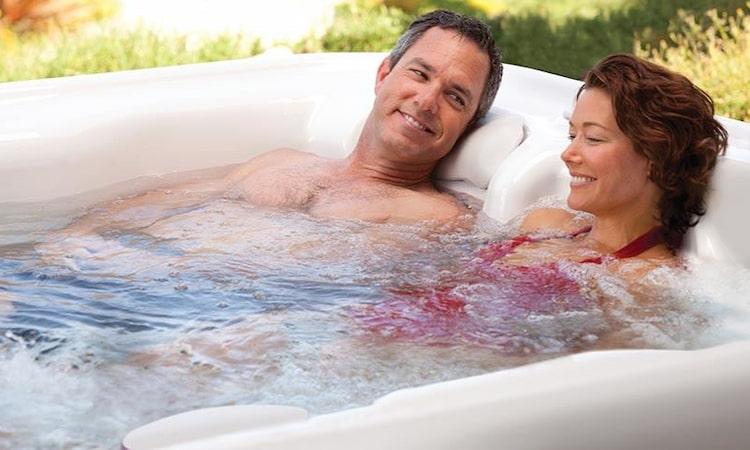
While adults can generally withstand longer periods in a hot tub, it’s recommended that you don’t exceed 20 minutes at a time, and you should always stay hydrated. The reason behind this time limit is simple; prolonged exposure to high temperatures can lead to overheating, causing light-headedness, dizziness, or worse, heat stroke. So, keeping your dips short and sweet helps maintain a healthy balance.
Proper hot tub usage requires a few additional precautions. Here are some to keep in mind:
- Hydration is crucial: Always have a bottle of water nearby to replace the fluids you lose through sweating.
- Avoid alcohol: Alcohol can dehydrate you further and amplify the effects of the heat, which can be dangerous.
- Control the temperature: The water should not be hotter than 104 degrees Fahrenheit (40 degrees Celsius) to prevent burns and other heat-related injuries.
Lastly, remember that hot tub maintenance goes hand in hand with safe usage. Regularly test the water for correct pH and disinfectant levels, clean the filters, and change the water as recommended by the manufacturer. By doing this, you’ll ensure a safe and enjoyable hot tub experience.
Special Considerations for Seniors Using Hot Tubs
In your golden years, there are a few extra precautions you’ll need to take when using a hot tub. First, always check the water’s temperature before immersing yourself. Prolonged exposure to water temperatures above 104°F can lead to overheating and dehydration, especially in seniors.
Next, consider the time you spend soaking. Limit your sessions to 15-20 minutes, taking breaks to cool down. This helps prevent any dizziness or light-headedness when you stand up.
You also need to pay attention to hot tub hygiene. Bacteria and other microbes can thrive in warm water, so make sure your tub’s filtration system is working properly and the water’s pH level is balanced. Regular maintenance is essential.
Lastly, don’t forget about getting in and out of the tub. Install sturdy handrails and anti-slip mats to prevent falls. Always use the handrails when entering or exiting the tub, even if you feel steady.
Frequently Asked Questions
You should change your hot tub’s water every three to four months. It’s crucial to maintain cleanliness, ensuring it’s safe for use. Regular water changes will help keep bacteria and chemicals balanced.
Regardless of age, certain health conditions can limit your hot tub use. If you’ve heart issues, high blood pressure, or skin conditions, it’s best to consult your doctor before you soak. Safety first, always.
Yes, you can use a hot tub while pregnant, but cautiously. Don’t exceed 10 minutes, keep water below 100°F, and avoid immersion up to your shoulders. Always consult your doctor beforehand for personalized advice.
Yes, you should use specific cleaning products for your hot tub. Regularly apply a non-abrasive cleaner for the shell and a biofilm remover for the water. Always follow the manufacturer’s instructions to ensure safe usage.
It’s safe for you to soak in a hot tub for about 15-30 minutes. Prolonged exposure can lead to overheating or dehydration, so always ensure you’re hydrated and take breaks if you’re feeling dizzy or lightheaded.
Conclusion
So, remember, hot tubs aren’t safe for children under five. Older kids should use caution and limit soak time. Adolescents can enjoy safely but should also monitor time and temperature.
Adults, enjoy responsibly and keep an eye on your health. Seniors pay attention to how your body feels and consult your doctor if necessary. Hot tubs can be a great source of relaxation, but safety should always be the top priority.

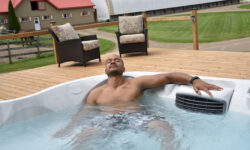
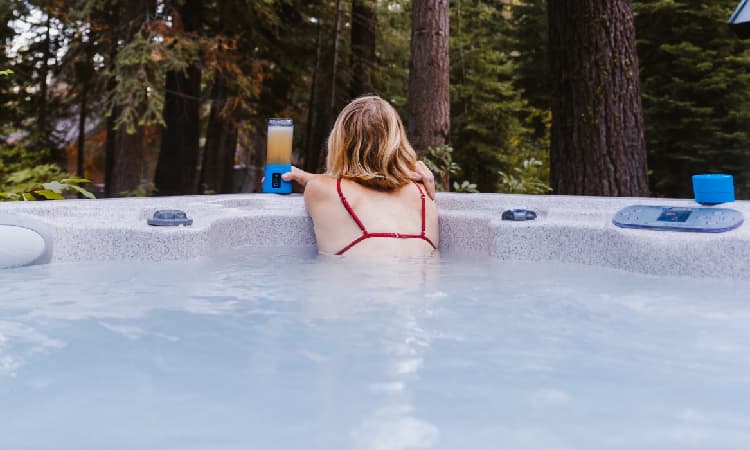


![Is Hot Tub Good for Cold? [Potential Risks & Precautions] Is Hot Tub Good for Cold](https://hottubtales.com/wp-content/uploads/2023/10/Is-Hot-Tub-Good-for-Cold.jpg)
